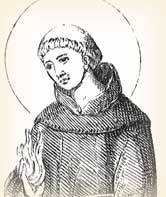
Trying to find a passage of scripture in your study Bible? Chances are you will flip to the concordance in the back. There you can search for your topic in an alphabetical list of words. The word you are looking for appears in a cropped sentence--a little additional text being given to help you identify which passage you are looking for. The concordance points you to chapters and verses. It is one of the most powerful scripture tools at our command.
Hugh of St. Cher, a Dominican, made the first significant concordance of the Bible. This was for the Latin Bible, the Vulgate. He is said to have had the help of 500 Dominican friars. The only other person known to have attempted to compile a Bible concordance before him was St. Anthony of Padua. Hugh's concordance only gave the Latin word but did not give any of the text around it. This made it crude by modern standards. All the same, it served as a basis for the work of men who soon came after him.
Bible chapters had not yet been broken into verses. In order to help scholars find words, Hugh broke each chapter into seven parts to which he gave letters of the alphabet.
The concordance was only one of three tools that Hugh gave the Dominicans. Each of them was needed to assist the order to meet their goal of preaching the Gospel. One of his other efforts was an attempt to correct the errors of the Vulgate. However, he did not know that Jerome had made the original translation and often turned down Jerome's comments in favor of the ideas of other writers. When the church learned that Jerome had actually made the Vulgate translation, Hugh's work lost all credibility.
Hugh also wrote a commentary on the whole Bible. It was still in demand five hundred years later! This included the opinions of many notable theologians of his own era.
In addition to his scholarly work, Hugh was serious about preaching. He once wrote, "if a man is known to be without the grace for it he ought not to be sent out on any job of public preaching."
He was also deeply engaged in the church politics of the day. At various times, popes employed him on important missions. Once he was sent to Constantinople, no easy journey in those days. When the pope needed someone to reform one of the Catholic orders, the Carmelite rule and liturgy (order of service), it was the Bible scholar Hugh that he chose to do the job. Hugh became the first Dominican raised to the rank of Cardinal.
But it is as a Bible scholar that we remember him. When he died on this day, March 19, 1263, he left behind him a solid body of work that greatly helped future students of the Scriptures.
Bibliography:
- "Concordance." Encyclopedia Americana. Chicago: American Corp., 1956.
- Gigot, Francis E. "Hugh of St. Cher." Catholic Encyclopedia. New York: Robert Appleton, 1910.
- Smith, A. "Hugh of St. Cher." New Catholic Encyclopedia. New York: McGraw-Hill, 1967.
- Sullivan, Fr. J. M. "The Preacher Hugh of Saint Cher: Scripture Study and the Salvation of Souls." http://www.wordofgodinstitute.org/ Old/Old_hughcher.htm